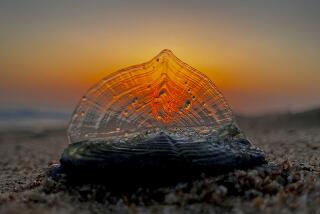Don’t swim with the sharks -- or tangle with the jellyfish
Sharks get the headlines, but other sea creatures are statistically more likely to harm ocean-bound vacationers this summer, experts say.
Stings from jellyfish and the Portuguese man-of-war are more common than shark bites, says Dr. Arlen Stauffer, who practices emergency medicine at Bert Fish Medical Center in New Smyrna Beach, Fla. There, he says, “3 million people visit the beach each year, and we average 10 shark bites.” Come summer, his emergency staff will treat that many jellyfish and man-of-war stings in a single month, while countless other stings go unreported or are treated by lifeguards at the beach.
Some jellyfish are more dangerous than others, Stauffer says, adding, “In our country, jellyfish stings are very painful but generally not life threatening, except on rare occasions.”
But in Australia, he says, common jellyfish such as the Irukandji are more toxic and potentially fatal. How can travelers protect themselves?
“Know the local conditions,” says Rob Miller, a lifeguard for the city and county of Honolulu. Ask residents, talk with lifeguards and check out Web pages such as www.aloha.com/~lifeguards/hazards1.html.
“In Hawaii, the box jellyfish come in between the eighth and 12th day after a full moon,” Miller says. “Waikiki is almost always where they come in.”
Jellyfish emit poison through long tentacles, which contain stinging cells. If you are stung, treat the area with white vinegar, Miller says. Often lifeguards keep vinegar at their stations.
“Do not rub it in,” Miller says, because that could push tentacles farther into the skin.
Vinegar often neutralizes the poison and eases the pain, but not necessarily immediately, Stauffer says. “Sometimes you have to keep a little vinegar on it for an hour,” he says.
If the vinegar doesn’t relieve the pain, Miller suggests heat packs or a hot shower. If you have difficulty breathing, tightness in the chest or other serious symptoms, seek emergency help.
The Portuguese man-of-war, a jellylike animal that looks like a fragile blue bubble, can deliver a painful, powerful sting. They’re often found when ocean winds blow toward land, and treatment is similar to that for jellyfish stings.
“We put vinegar everywhere that has been stung,” Stauffer says. Severe symptoms such as breathing difficulty warrant immediate medical attention.
Stingrays -- those flat, bottom-dwelling fish -- also can be dangerous, says Dr. Allen Perkins, professor and vice chairman of the family medicine department at the University of South Alabama College of Medicine, Mobile. He recently published a report on marine hazards in the journal American Family Physician.
“Stingrays hide in the sand, and people step on them accidentally,” Perkins says. The problem: Most species have poisonous, spiked spines that can cause serious cuts.
“If you get a bad cut in the water, no matter what, you should seek treatment,” Perkins says. If medical help isn’t immediately available and the cut isn’t deep, he says, soak the affected area in warm water for 30 minutes to deactivate the venom.
Prevention, however, may be the best solution. Stauffer helped one company test a sun-block lotion, sold online at www.nidaria.com, that supposedly protects against jellyfish stings. Miller suggests that travelers simply talk with a lifeguard about conditions and risks.
If a lifeguard isn’t around, Miller says, look for signs warning of jellyfish or other dangers -- and heed the advice.
Healthy Traveler appears every other week. Kathleen Doheny can be reached at kathleen doheny@earthlink.net.
More to Read
Sign up for The Wild
We’ll help you find the best places to hike, bike and run, as well as the perfect silent spots for meditation and yoga.
You may occasionally receive promotional content from the Los Angeles Times.





